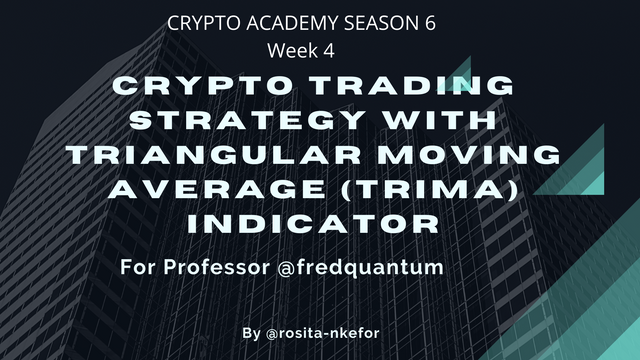
Crypto Trading Strategy with Triangular Moving Average (TRIMA) Indicator


Indicators are very important tools used in technical analysis. This is because they help traders to understand how the price of an asset he been moving and to pick up patterns in it's movement.
As we know, most traders use candlestick charts which give so much information about the price like the high, low, open and close prices. At times, all these many prices generate too much noise in the market and traders are unable to see what they are looking for.
This is where Moving Averages enter. They use certain calculations to smoother the price to a single line over a given time period. Moving Averages became so useful and important that many people started to work on them to get something better than what was gotten.
Because of this craving for more accuracy, variants of moving averages were created. The Triangular Moving Average also called the TRIMA, is one of those variants.
So now what exactly is the TRIMA? The TRIMA is simply a tool that provides information used in technical analysis. It does this by giving it's value as the average of an asset two times over a period of time. Since it does the average twice, it is referred to as double smoothing.
But why smooth prices two times? Why not just be satisfied with the SMA which is where the TRIMA is derived? The reasons are quite simple actually.
It's double smoothing feature, makes it better because it prevents the indicator from reacting too instantly to the price movement. This makes the indicator truly filter out the noise as certain movements that can deceive the trader are not considered.
Due to this, the indicator works so well in helping traders to see the actual trend in the market. Since it smooths every little price change twice, traders no longer become a victim of price manipulation.
It also does help that it works very well when used in confluence with other indicators to confirm signals from the market.


For this question, I shall be using Trading View. You'll go to Trading View and launch any chart. I chose the TRX/USDT crypto pair in the 15 minute timeframe.
When you're in the chart, you are going to look at the long tab above the chart and click on the Indicators tab.
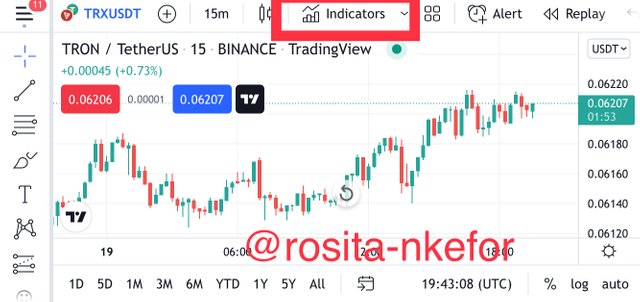
When the indicator pop up appears, go to the search bar and search for the Triangular Moving Average. The first one that comes up in the search is it. Click on the indicator to apply it to the chart.
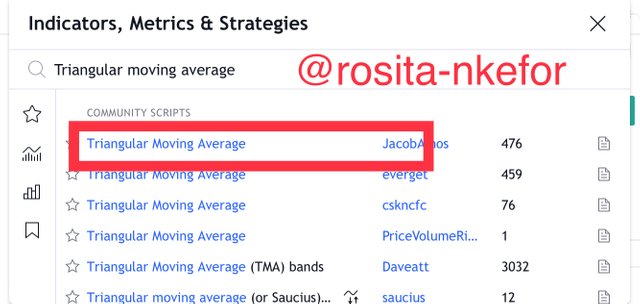
As you can see, the indicator is not applied to the chart. The time period for the default TRIMA is 10 candles while the price being used are the close prices. But if you don't like these default settings, you can click on the settings icon on the indicator tab.
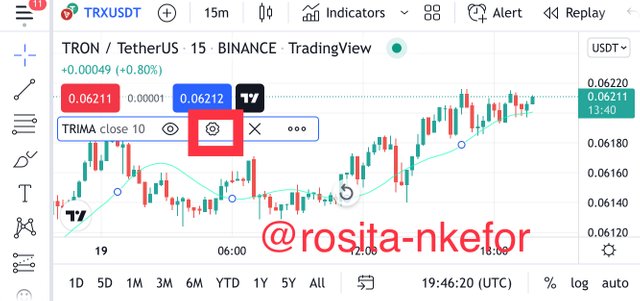
In the settings, you can change what you want to use for your data under source and also change the time periods used for the calculations of the TRIMA.
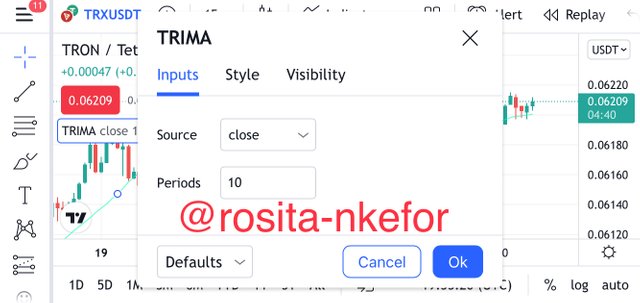
Under style, you can change the colour of the TRIMA and the precision.
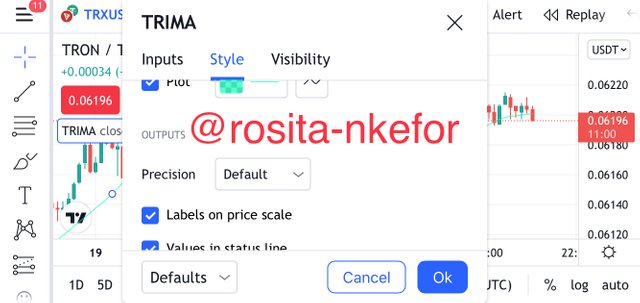
Under visibility, you can change what and how visible it should be in certain timeframes.
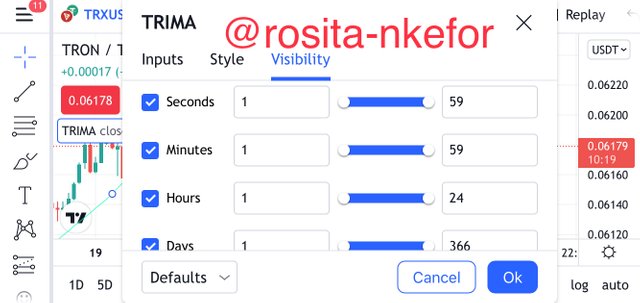
TRIMA calculation
The TRIMA indicator is a mathematical model that uses prices and time periods to get it's different values which form the oscillating line. Now how are the values calculated? It is by using the following formula.
TRIMA = [SMA1 + SMA2 + SMA3 + SMA4 + SMA5... + SMAn]/n.
Where,
n = number of time periods
SMA: (P1 + P2 + P3 + P4 + P5... + Pn)/n with Pn being the price of the asset at the time period n.
So we can see the double smoothing in effect. The average of the prices are gotten to give the SMA. Then the average of the SMAs is gotten as well.


Uptrends and TRIMA
You have to apply the TRIMA indicator to the chart first. Now how do you know that the market is in an uptrend?
We know that the TRIMA oscillates along with price. Now when the TRIMA is moving below the price, we say that the market is in an uptrend.
Below is an example of an uptrend using the TRIMA 20 indicator on a TRX/USDT crypto pair in a 15 minute timeframe.
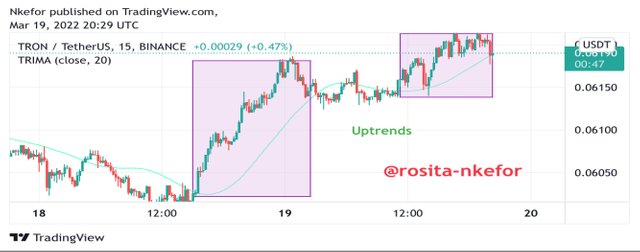
We can clearly see from the chart above that when the TRIMA is below the price, the price is on a bullish run.
Downtrends and TRIMA
Now how do you know when the market is in a downtrend using the TRIMA indicator?
When the TRIMA oscillates and starts moving above the price, the market is identified to be in a downtrend.
Below is an example of a downtrend using a TRIMA
20 on a TRX/USDT crypto pair in a 15 minute timeframe.
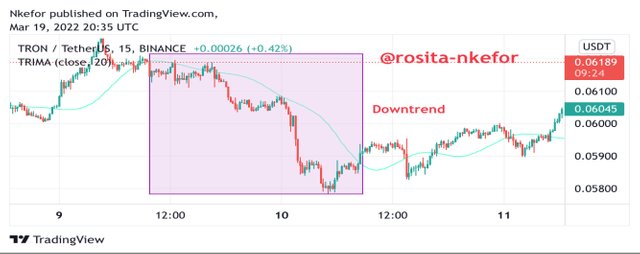
We can clearly see that when the TRIMA is moving above the price, the candles are moving in a bearish manner.


TRIMA as a dynamic support and resistance
Dynamic resistance as support levels are simply price levels that price finds it hard to go against, which move along with the price. As we all know, moving averages are one of the best dynamic resistance and supports out there. Now how does the TRIMA act as a dynamic support or resistance?
- As dynamic resistance
I shall illustrate this using the TRX/USDT crypto pair in a 15 minute timeframe. I prefer to use the TRIMA 20 because it is not too large to cancel out important signals but at the same time, it is not too small to consider every little price change.
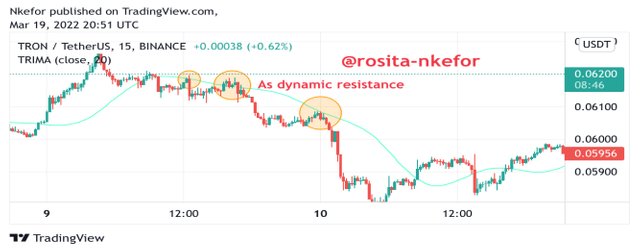
As can be seen on the chart, the price goes up forming a high at the TRIMA before going back down. When forming the next new high, it finds it difficult to break through the TRIMA since it lacks momentum and thus rebounds forming a lower low. Upon the third time, it still rebounds at the TRIMA and forms a lower low.
After that it, buyers start to gain momentum in the market which forces the price to break through the TRIMA.
- As a dynamic support
I will be using the TRX/USDT crypto pair in a 15 minute timeframe. The TRIMA 20 will act as my dynamic support.
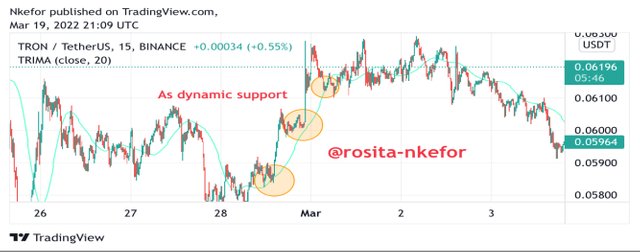
As can be seem from the chart, the price firms a low which lies on the TRIMA. It then rebounds and forms a new high. But when it comes to form itsylow, it finds it difficult to break through the TRIMA and thus rebounds firming a new higher high.
It comes down to the TRIMA once more but still finds it difficult to breakthrough, causing it to rebound and more. When it now comes to the TRIMA, the sellers gather momentum such that though the price rebounds, it quickly drops and breaks through the TRIMA.
TRIMA in a consolidating market
We already know that when the buyers are in control (bullish) the TRIMA goes below the price and when the sellers are in control (bearish), the TRIMA goes above the price. Now what happens in a consolidating market?
When the market is consolidating, that means that buyers and sellers are fighting for control. The TRIMA will go above the price just to go below the price a few moments later. This is because of the fighting.
As a result, the TRIMA ends up just weaving in and out of the price as the fight for control continues. Below is an example on a TRX/USDT pair in a 15 minute with the TRIMA 20.
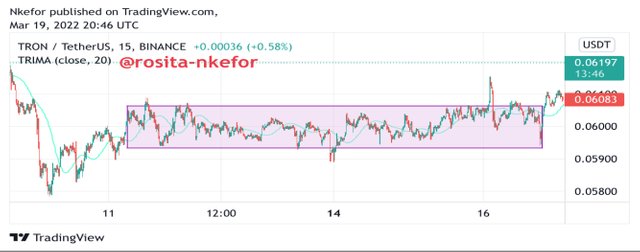
We can easily see the TRIMA moving in and out of the price as the market consolidates with both parties fighting to take charge.


The time period used to calculate a TRIMA determineshow quickly it will react to the price and how close it will be to the price on the chart. A TRIMA with a shorter time period will move very closely to the chart while a TRIMA with a longer time period will not bec that lose to the price.
When combining TRIMAs to use in technical analysis, it is advisable to use one with a shorter time period and another with a longer time period. The shorter one shows the smallest price changes while the longer one filters the market out for more faraway look on things.
Now what actually concerns us when using two TRIMAS will be what happens when they cross each other. How is it interpreted?
There are two types of cross overs. The golden cross and the death cross. These names are applied across the different variants of moving averages.
Golden Cross
The golden cross occurs when the TRIMA with the shorter time period moves above the TRIMA with the longer time period. This cross indicates that the market is about to enter an uptrend.
As soon as this cross over occurs, a trader can get a good entry point to place a long trade after the confirmation of at least two bullish candles.
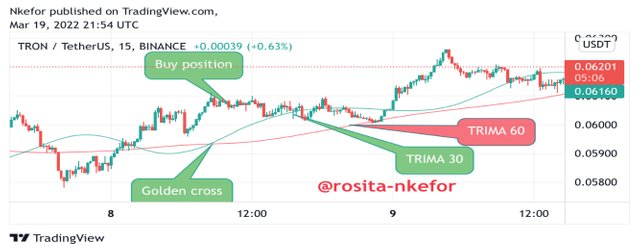
Death Cross
This type of cross over occurs when the TRIMA with a shorter time period moves below the TRIMA with a longer time period. It tells us that the market is about to go into a downtrend.
As soon as the cross over occurs, we can go ahead and take out entry position to place a short trade after at least two bearish candles have formed.
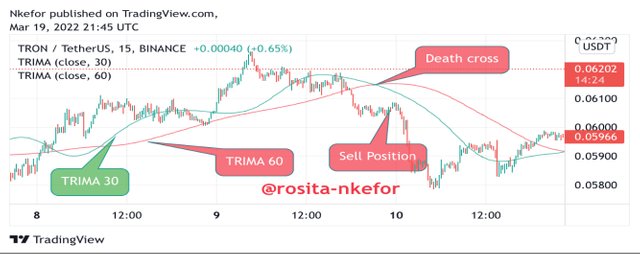
Above is an example of a death cross over on TRX/USDT pair in a 15 minute timeframe. My chosen TRIMAs are the TRIMA 30 and the TRIMA 60. As you can see, when the death cross occurs, the price starts going bearish. This, a good entry position for a sell trade will be some candles after the cross over.


Conditions for Trade Reversal using TRIMA and RSI
- Bullish reversal
- Firstly, add the RSI, a shorter time period and longer time period TRIMA to the chart.
- Wait for the RSI to indicate oversold which indicates a bullish reversal is to occur
- Also check for the shorter time period TRIMA to go above the longer time period TRIMA which we saw above tells us that the market wants to go bullish.
- Now place your long trade putting proper take profit and stop loss.
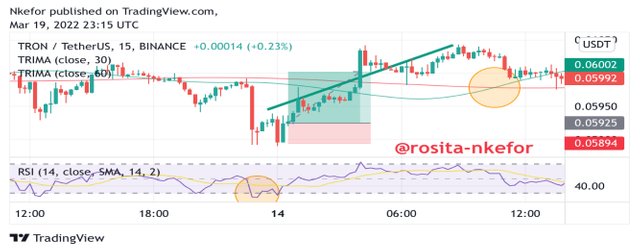
Above is an example of a bullish reversal on a TRX/USDT chart in a 15 minute timeframe using the TRIMA 30, TRIMA 60 and RSI.
- Bearish reversal
- Firstly, apply the RSI, short term TRIMA and long term TRIMA to the chart.
- Wait for the RSI to indicate overbought which signifies that the market is about to go on a bearish run.
- Also wait for the short term TRIMA to go below the long term TRIMA (death cross).
- With all these confirmations, you can now place a short trade with proper take profit and stop loss.
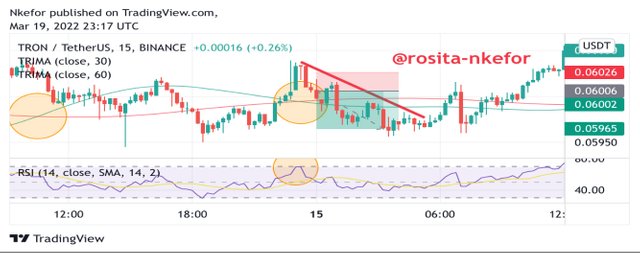
Above is an example of a bearish reversal on a TRX/USDT chart in a 15 minute timeframe using the TRIMA 30, TRIMA 60 and RSI.
Conditions for Trade Reversal using TRIMA and Stochastic Oscillator
Another indicator which you can use alongside the TRIMA is the stochastic oscillator.
- Bullish reversal
- Apply the stochastic, short term and long term TRIMA to the chart.
- Wait for the stochastic oscillator to indicate oversold.
- Wait for the short term TRIMA to go above the long term TRIMA.
- Place your buy trade now with good stop loss and take profit.
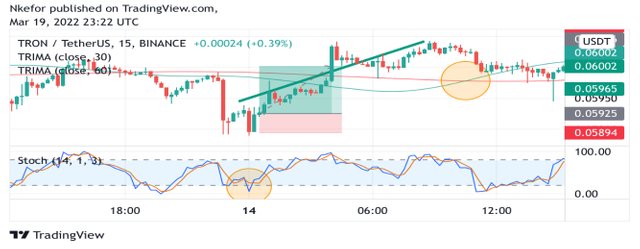
Above is an example of a bullish reversal on a TRX/USDT chart in a 15 minute timeframe using the TRIMA 30, TRIMA 60 and Stochastic
- Bearish reversal
- Apply the stochastic, short term and long term TRIMA to the chart.
- Wait for the stochastic I dictator to indicate overbought.
- Wait for the short term TRIMA to go below the the long term TRIMA.
- Go ahead to place your sell trade with proper risk management employed.
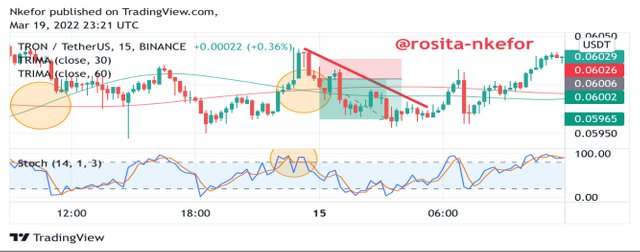
Above is an example of a bearish reversal on a TRX/USDT chart in a 15 minute timeframe using the TRIMA 30, TRIMA 60 and Stochastic.


Bullish Reversal
- Demo Trade
I performed the demo trade on an STX/USDT pair in a 3 minute timeframe. I used the TRIMA 30, TRIMA 60 and RSI indicators.
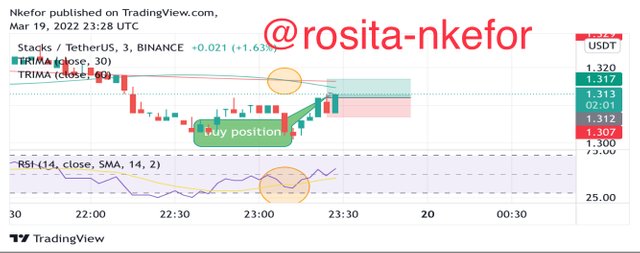
From my chart, I observed that the RSI had hit the oversold line. I also saw that the TRIMA 30 went above the TRIMA 60 forming a golden cross. I saw my perfect entry to place a long trade. My risk to reward ratio was almost 1:1.

Bearish Reversal
- Real Trade
I performed the real trade on the GRT/USDT Crypto pair in a 1 minute timeframe. I applied the TRIMA 30, TRIMA 60 and the RSI indicators.
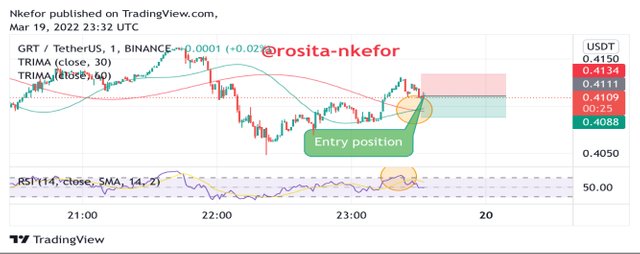
I observed that my RSI had reached the overbought region. Also, the TRIMA 30 went below the TRIMA 60 forming a death cross. So I had the perfect opportunity to place my short trade.
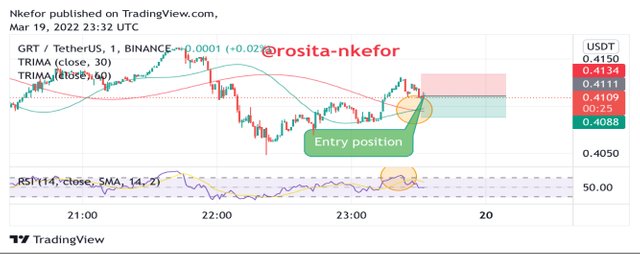
I then went to my binance and placed my trade. I could not use my stop loss and take profit so I just placed an open position.
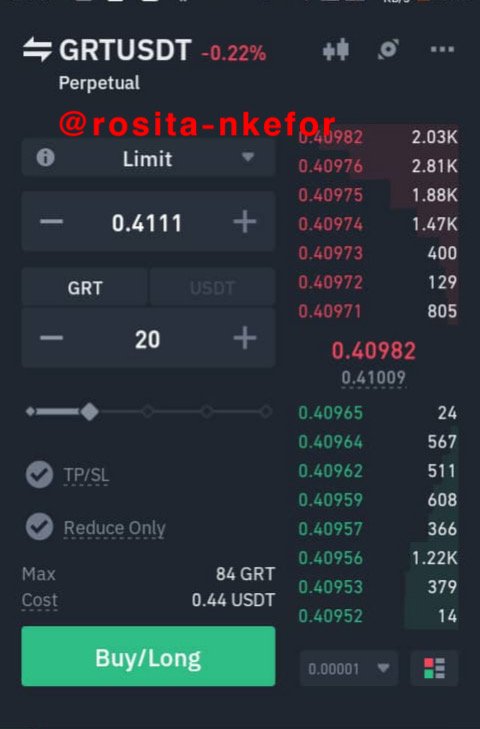
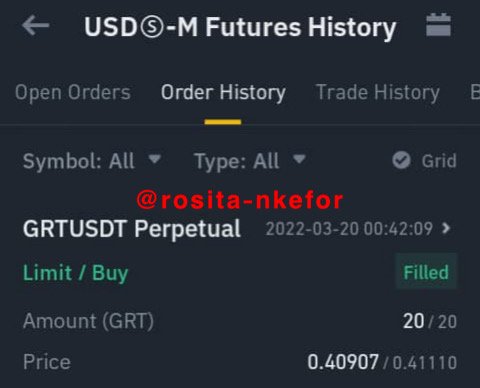


Advantages
- Due to it's double smoothing feature, it allows for higher filtering of noise in the market.
- It allows traders to see the trend in the market just by looking at the position of the price relative to the TRIMA.
- More accurate entry points can be gotten by the use of cross overs.
- It reduces the chances for a trader to fall for price manipulation in the market.
- They can easily be used in confidence with other indicators.
Disadvantages
- On it's own, it can sometimes give false signals and thus, a trader who wants to minimise loss
will be forced to use it with another indicator. - It is a lagging indicator that is the price moves in the market before this movement is recognised by the TRIMA. This delay can make traders miss good entry points.
Conclusion
The TRIMA is a very interesting variant of the moving average. It is based on a other variant is which the SMA. Because of this, it has the unique double smoothing feature which allows it to work better than the SMA.
The indicator allows one to easily determine the market condition of an asset (rising, falling, consolidating). It also helps traders to get good entry positions when combining two TRIMAs through the use of cross overs.
This indicator though a lagging one, produces great results especially when combined with another indicator as it allows fake signals to be easily filtered out.
Thanks for reading.